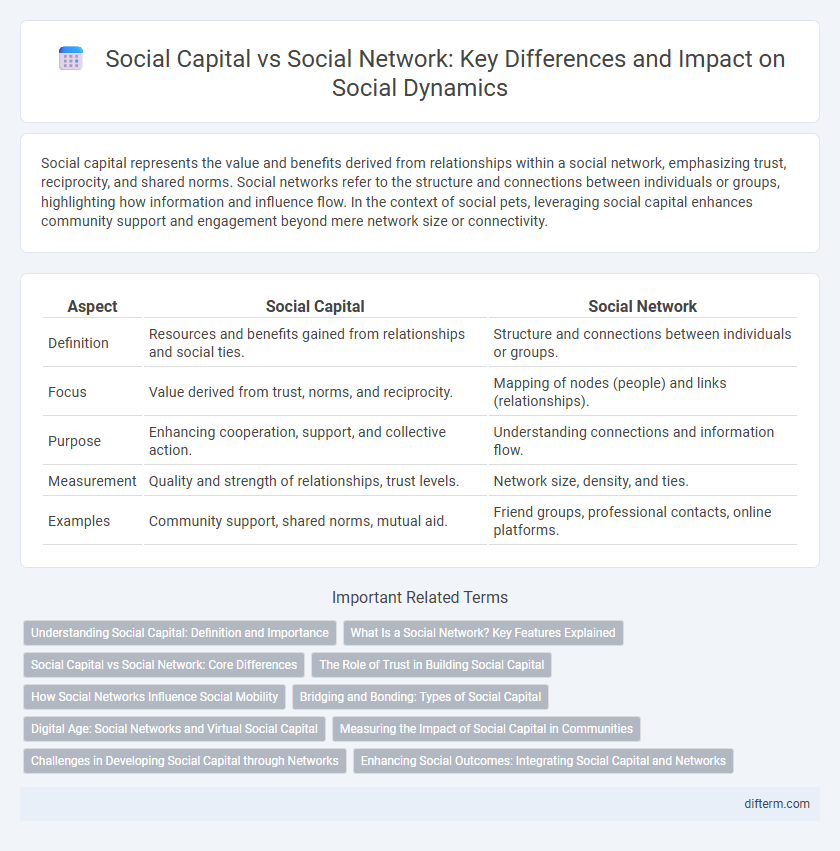Social capital represents the value and benefits derived from relationships within a social network, emphasizing trust, reciprocity, and shared norms. Social networks refer to the structure and connections between individuals or groups, highlighting how information and influence flow. In the context of social pets, leveraging social capital enhances community support and engagement beyond mere network size or connectivity.
Table of Comparison
| Aspect | Social Capital | Social Network |
|---|---|---|
| Definition | Resources and benefits gained from relationships and social ties. | Structure and connections between individuals or groups. |
| Focus | Value derived from trust, norms, and reciprocity. | Mapping of nodes (people) and links (relationships). |
| Purpose | Enhancing cooperation, support, and collective action. | Understanding connections and information flow. |
| Measurement | Quality and strength of relationships, trust levels. | Network size, density, and ties. |
| Examples | Community support, shared norms, mutual aid. | Friend groups, professional contacts, online platforms. |
Understanding Social Capital: Definition and Importance
Social capital refers to the resources and benefits individuals gain from their relationships, characterized by trust, reciprocity, and social norms that facilitate cooperation and collective action. Unlike social networks, which simply map connections between individuals or groups, social capital emphasizes the quality and value embedded within those ties that enhance social cohesion and economic opportunities. Understanding the importance of social capital highlights its role in community development, improving social well-being, and fostering resilience in various social contexts.
What Is a Social Network? Key Features Explained
A social network is a structure of interconnected individuals or organizations that facilitate communication and resource exchange. Key features include nodes representing members, edges symbolizing relationships, and clusters indicating closely-knit groups. This framework enables efficient information flow and support within communities, distinguishing it from the broader concept of social capital, which emphasizes the value derived from these connections.
Social Capital vs Social Network: Core Differences
Social capital refers to the value derived from relationships and social interactions, emphasizing trust, norms, and mutual support within communities. Social networks represent the structural connections between individuals or groups, highlighting who is connected to whom without necessarily implying the depth of those relationships. Core differences lie in social capital's qualitative benefits versus social network's quantitative mapping of social ties.
The Role of Trust in Building Social Capital
Trust serves as the cornerstone of social capital by fostering mutual cooperation and shared norms within communities. Social networks provide the structural framework for connections, but trust determines the strength and reliability of these relationships. High levels of trust enhance resource exchange, collective action, and overall social cohesion, making trust essential for transforming social networks into robust social capital.
How Social Networks Influence Social Mobility
Social networks serve as channels for social capital by providing access to resources, information, and opportunities essential for social mobility. The strength and diversity of an individual's network can significantly affect their ability to climb socioeconomic ladders through connections that offer job referrals, mentorship, and community support. Empirical studies show that bridging social capital, which connects disparate social groups, is particularly influential in expanding social mobility and reducing inequality.
Bridging and Bonding: Types of Social Capital
Bridging social capital refers to connections that link diverse social groups, fostering inclusivity and access to broader resources, while bonding social capital strengthens ties within a homogenous group, promoting trust and mutual support. Bridging networks often facilitate innovation and new information through weak ties, whereas bonding networks reinforce solidarity and emotional support among close-knit members. The balance between these types of social capital is crucial for social cohesion and collective action in communities.
Digital Age: Social Networks and Virtual Social Capital
Digital platforms have transformed social networks into dynamic spaces where virtual social capital is accumulated through interactions, trust, and shared norms. Unlike traditional social capital, which relies on face-to-face relationships, digital social networks enable broader connectivity that transcends geographical boundaries, fostering new forms of collaboration and resource exchange. The strength of virtual social capital is measured by the quality of digital ties and the ability to mobilize support within these online communities.
Measuring the Impact of Social Capital in Communities
Measuring the impact of social capital in communities involves assessing trust, reciprocity, and collective action within social networks that connect individuals. Social capital enhances community resilience and economic opportunities by fostering cooperation and access to resources, whereas social networks primarily map relationships and interactions. Quantitative metrics like network density and qualitative evaluations of social cohesion help capture the true benefits of social capital beyond mere connections.
Challenges in Developing Social Capital through Networks
Developing social capital through social networks often faces challenges such as limited trust and reciprocity among members, which can hinder the formation of strong, supportive relationships. Structural holes and weak ties in networks reduce opportunities for resource sharing and collective action, impairing the growth of social capital. Furthermore, diversity and heterogeneity in social networks can create communication barriers and conflicting interests, complicating the establishment of cohesive social capital.
Enhancing Social Outcomes: Integrating Social Capital and Networks
Integrating social capital and social networks enhances social outcomes by leveraging trust, shared norms, and reciprocity within interconnected relationships. Social capital fosters cooperation and collective action, while social networks provide the structure through which resources and information flow efficiently. Combining both concepts enables stronger community resilience, improved access to opportunities, and greater social cohesion.
social capital vs social network Infographic

 difterm.com
difterm.com